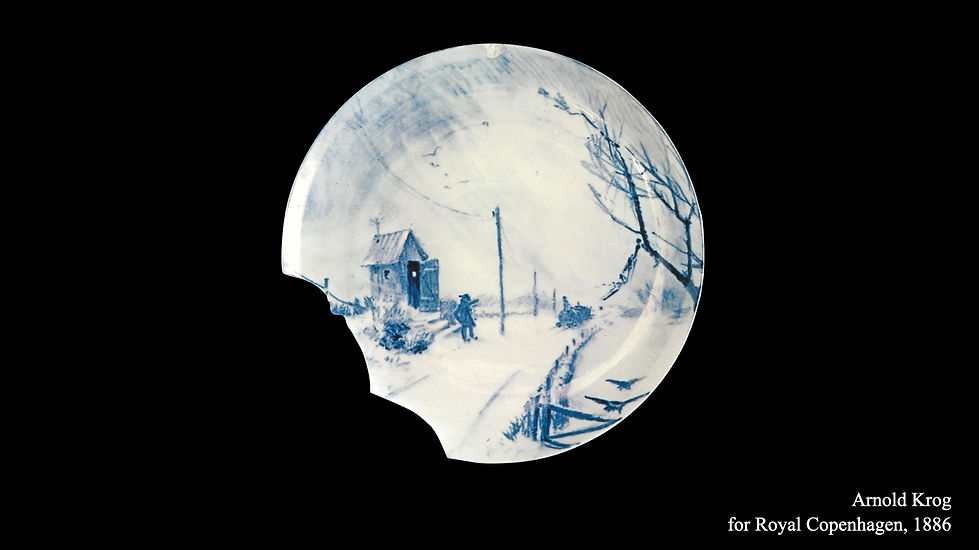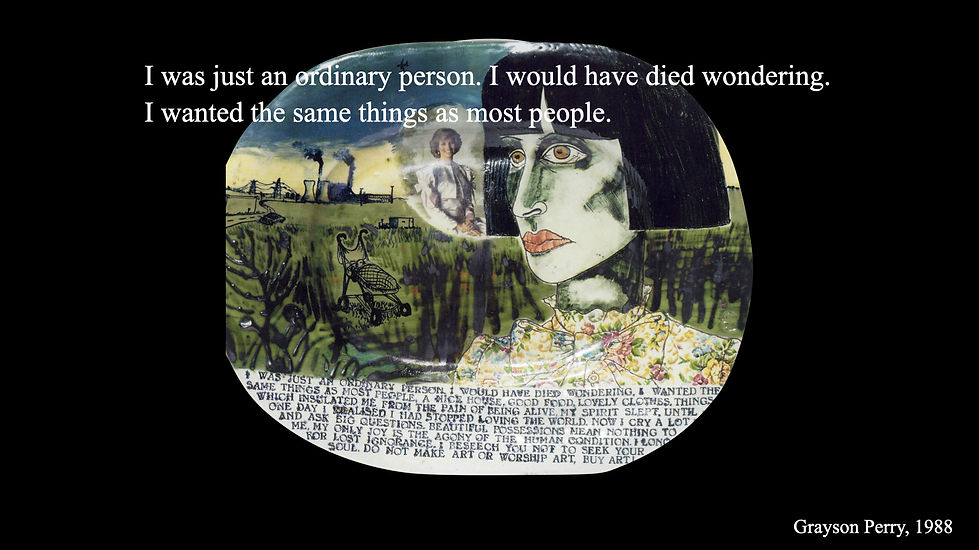Josephine Sassu
Oslo National Academy of the Arts, 2024
A guided tour through my thesis:
What Is Culinary Spatial Practice?
This project investigates how interior design can shape and enhance the experience of eating. Through a series of short essays, I look at Nordic cuisine and explore how ideas as seasonality, locality and emotivity can inform the design of culinary spaces. The work sits between theory and practice and aims to open a conversation about how we design the dining environments of today and tomorrow.

The most immediate spaces around food are often plates. In the following I have chosen plates that either symbolically represent a thought or that are aesthetically associated with it.

Through this artistic research, I wanted to shift the focus from creating a surrounding based on aesthetics to communicating a coherence that revealed the interconnections between objects, spaces and people and thereby also the cultural narratives the food embodies.

In a way this was a project about story-telling.
A chef can tell a story through ingredients and composition — and I wanted to see whether I could tell the same story through objects in a space.
So in this project, my design is the transposition of values from one domain to another, my design is the act of translation which came down to a collection of essays that can be described as something between conceptual design practice and critical theory.

Within this project my conceptual framework focused on the act of translation. To translate means to convert or render meaning from one form or system to another. It derives from the Latin verb "transferre," meaning to carry across.
Hence, this project is a “carrying-across” of values, practices and ideas from the domain of the culinary to the world of design.

Ethically there was something I had to consider: Most of the book sources on New nordic cuisine and its practices are publicised by haute cuisine restaurants as proves of their extraordinary way of handling and understanding produce. How would that affect my work of translation?

I want to introduce you to Flora Danica to explain this thought. In the age of enlightenment, botanist Georg Christian Oeder was sent out by King Christian VII to paint all the flowers that bloom in Denmark. Oeder spent 9 years on the drawings, they were meant as a gift for Catherina the Great. However, she died before the set was ready. That is how it became the royal Danish table service. In its completness, the project Flora Danica took 122 years to completion and contains more than 3500 works.
I did not want my project to be a work on the greatness and luxury of haute cuisine. I wanted it to be about the preciousness that can be found in the amount of time some of these restaurants put into research and development for what they perceive as an alternative utopia for food culture.
These experimental sites, their urge to understand their local habitat, those were the values I decided to translate.


An insight, that started a learning process within me were Jane Rendell’s explanation of critical theory and Ina Blom’s idea behind style-site. Both of those concepts frame an element that has been interesting to me for many years: design as communication.
Rendell defines critical theory “as a self-reflective form of practice in its own right, one that is both creative and speculative, that engages with the world and seeks to act to change things”.
This understanding suggests a communication between the designer themselves – self-reflective – and a communication with the rest of the world.

Ina Blom’s concept of the style-site originally derives from art criticism, however adapting my understanding of it to the field of design, broadened my understanding of how the communicative aspect of design. The translation of Blom’s idea suggests a silent dialogue between the object and the viewer/recipient, and emphasises its role in reflecting social identities and cultural processes.Her concept of “style-site” consists of the interplay between appearance, recognition and social identity.


Before understanding what critical theory and the style-site could be,
Design to me is the communication of culture – and all the visible and invisible interaction happening between spaces, objects and people. The silent social happenings in different scales:
Place,
space.
object
and people
and in this case also food.
To me this project was about understanding the driving forces behind what can be described as an atmosphere.

Looking for answers and possibilities, I approached culinary space from different scales – visible within the research and the result.

I listened to farmers, spoke to chefs, artists and ceramicists, collected existing knowledge from writings of architects, designers and theorists to continue building ideas on conducted field studies from the perspective of being a guest.


The biggest challenge however, was not the field work but organising the experiences, thoughts and input of others into a structure – or narrative. The challenge was to find out how I wanted to structure and communicate my findings : Would it be a handbook? A guide? A personal memoire? What story did I want to tell the reader? And what story did I want to tell myself? Figuring this out took me two attempts.

I focused on the act of translation as the cornerstone of my design practice and explored how this process can serve as a research foundation for future designs of culinary spaces.

Chapter 1
On expressing purity, freshness and simplicity
This is a direct connection to the first and most essential statement in the nordic kitchen manifesto. And just to explain: The nordic kitchen manifesto is a collection of 10 guidelines — basically the 10 commandments of taste and sustainability for nordic cuisine, signed by 12 (male) chefs from the nordic countries in 2004.
However, the first statement “To express the purity, freshness, simplicity and ethics we wish to associate to our region “– might need additional explanation regarding the use of the word “purity”. It is not to be read in a ideological or religious way —- more in a “free of what is not essential way”
Finding and understanding the essence of a produce through translating purity, freshness and simplicity.
Whereas purity describes the quality, the character of a space,
freshness communicates an immediacy – a relational closeness within and towards a space,
and simplicity is a means to compose a design or a space in the way its character becomes clearest visible.
The combination of these three ideas expresses the invisible understanding of the space – a similar concept to what Danish architect Dorte Mandrup characterises as the “irreplaceability” of a place.
Chapter 2
Time and Place
This chapter thematises what it means to put the essence in a context, being in connection with time and place, seasonality and locality. Moreover, I introduced a new layer with social and ecological qualities to the translation: the circularity of cultivating – harvesting – preserving and composting as concrete ways of enacting time and place.
Understanding the act of cultivating in interior architecture led to a close connection between design and culture, revealed design as a means to grow, preserve and care for culture, essentially, design as the cultivation of culture.
Through time and place closely connected to cultivating is the act of harvesting.
Harvesting describes the needed knowledge to rightly observe to determine the right moment of action and the feeling when the conditions align and everything seems to be just right – and ready to be harvested. In spatial terms that can be understood as the connection of inside to outside to be able to observe the changing of the surroundings.
Chapter 3
On finding newness in the existing / Transformation
The standing on the intersection between past, present and future is thematised in this chapter. I connect the topic inseparably with the urgency to work transformatively in architecture.
Diving into what preserving can mean for design,
I wonder whether buildings can be fermented in order to preserve their identity and sense of belonging, and
conclude that it in order to ferment a building, on must first design a carescape. Through adding an element of restoration through care with the act of composting, the carescape widened. Transformation now concerns not only buildings but our mindset, asking for alternatives to capitalism and whether transformation can communicate this thought of change.
These translation essays resulted in more questions than answers, something that I hope to open a conversation within design and culinary practises with. Let's enter the phase of concluding thoughts, the crumbs that would be left after all.

Throughout this project, I moved between the realm of the personal and the professional. I learned that personal and professional experiences are inherently interconnected in the life of a designer.
Through sensibilities and intuition, the personal realm informs and shapes the professional realm, contributing to a design that also communicates my own identity. What seems to emerge is yet another possible constellation of Blom’s idea of the style-site: a reciprocal dialogue between my work and me.
In the present and for the future.


I hope this to be a work that leads to a discussion on what culinary space is and what it can be, giving the reader a chance to reflect on their own encounters with spaces built around and for the experience of food.
